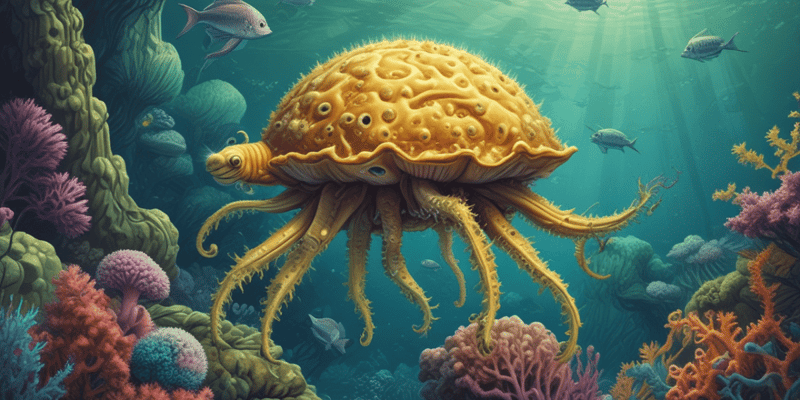Questions and Answers
What is the purpose of ctenophores' bioluminescence?
To protect against predators and attract prey
How do ctenophores reproduce asexually?
By consuming another ctenophore and absorbing its eggs for fertilization
What is the role of photophores in ctenophores?
To produce bioluminescent light through a chemical reaction
What is the main source of food for ctenophores?
Signup and view all the answers
What distinguishes cydippid in ctenophore reproduction?
Signup and view all the answers
What is the function of colloblasts in ctenophores?
Signup and view all the answers
What distinguishes ctenophores as basal animals in terms of evolution?
Signup and view all the answers
What role do ctenophores play in marine ecosystems?
Signup and view all the answers
What is the structure unique to the pharynx of ctenophores?
Signup and view all the answers
How do ctenophores contribute to their mesmerizing appearance?
Signup and view all the answers
Study Notes
Phylum Ctenophora: Exploring the Fascinating World of Comb Jellies
Ctenophora, commonly known as comb jellies, are a mesmerizing group of marine invertebrates characterized by their unique bioluminescent properties, digestive systems, evolutionary history, ecological roles, and reproductive strategies. In this article, we will delve into the subtopics surrounding these fascinating creatures.
1. Digestive System
Ctenophores possess a simple digestive system consisting of a single, long gut and a ciliary band called the colloblasts. Colloblasts are modified cilia that form concentric circles and wave in a coordinated manner, creating water currents that sweep food into the mouth. The food then passes through the pharynx, which possesses a unique structure called a pharyngostome. The pharyngostome acts as a valve to control the flow of food into the digestive tract.
2. Evolution
Ctenophores are considered basal animals, meaning they were among the first to evolve among the group that includes animals with a notochord (a flexible, rod-like structure in their bodies, which is absent in ctenophores). Fossil evidence suggests ctenophores appeared around 750 million years ago, making them one of the earliest marine invertebrates.
3. Ecology
Ctenophores are found in every ocean, often thriving in coastal waters. They are an essential part of marine ecosystems as both predators and prey. As predators, ctenophores feed on small zooplankton, while small ctenophores can also be prey for larger marine creatures. Their bioluminescent properties are crucial in their ecological role, as they use the light to deter predators and attract prey.
4. Bioluminescence
Ctenophores are renowned for their stunning bioluminescence. They possess photophores, specialized cells that emit light through a chemical reaction involving luciferin, an enzyme called luciferase, and a light-emitting molecule called coelenterazine. This light is used for various purposes, including communication, predator avoidance, and prey attraction.
5. Reproduction
Ctenophores reproduce both sexually and asexually. Sexual reproduction involves the fusion of male and female gametes to form a zygote, which then develops into a cydippid, a free-swimming larva. Asexual reproduction involves budding, where an outgrowth on the body forms a new individual that eventually breaks off.
Ctenophores have remarkable reproductive strategies. They produce both eggs and sperm simultaneously, allowing them to reproduce quickly in the right conditions. Additionally, they exhibit a peculiar reproductive behavior called "cannibalism." This occurs when a pregnant female consumes another ctenophore, which releases its eggs, and the pregnant female then ferilizes and absorbs those eggs.
To conclude, ctenophores are captivating creatures with a rich history, unique features, and essential roles within marine ecosystems. Their bioluminescent properties, digestive systems, evolutionary history, and reproductive strategies make them an intriguing subject for exploration. Learning about ctenophores not only enriches our understanding of marine life but also provides a deeper appreciation for the complex beauty of the natural world.
Studying That Suits You
Use AI to generate personalized quizzes and flashcards to suit your learning preferences.
Description
Test your knowledge about the captivating marine invertebrates known as the comb jellies. Explore their unique digestive systems, evolutionary history, ecological roles, and remarkable reproductive strategies through this quiz.




